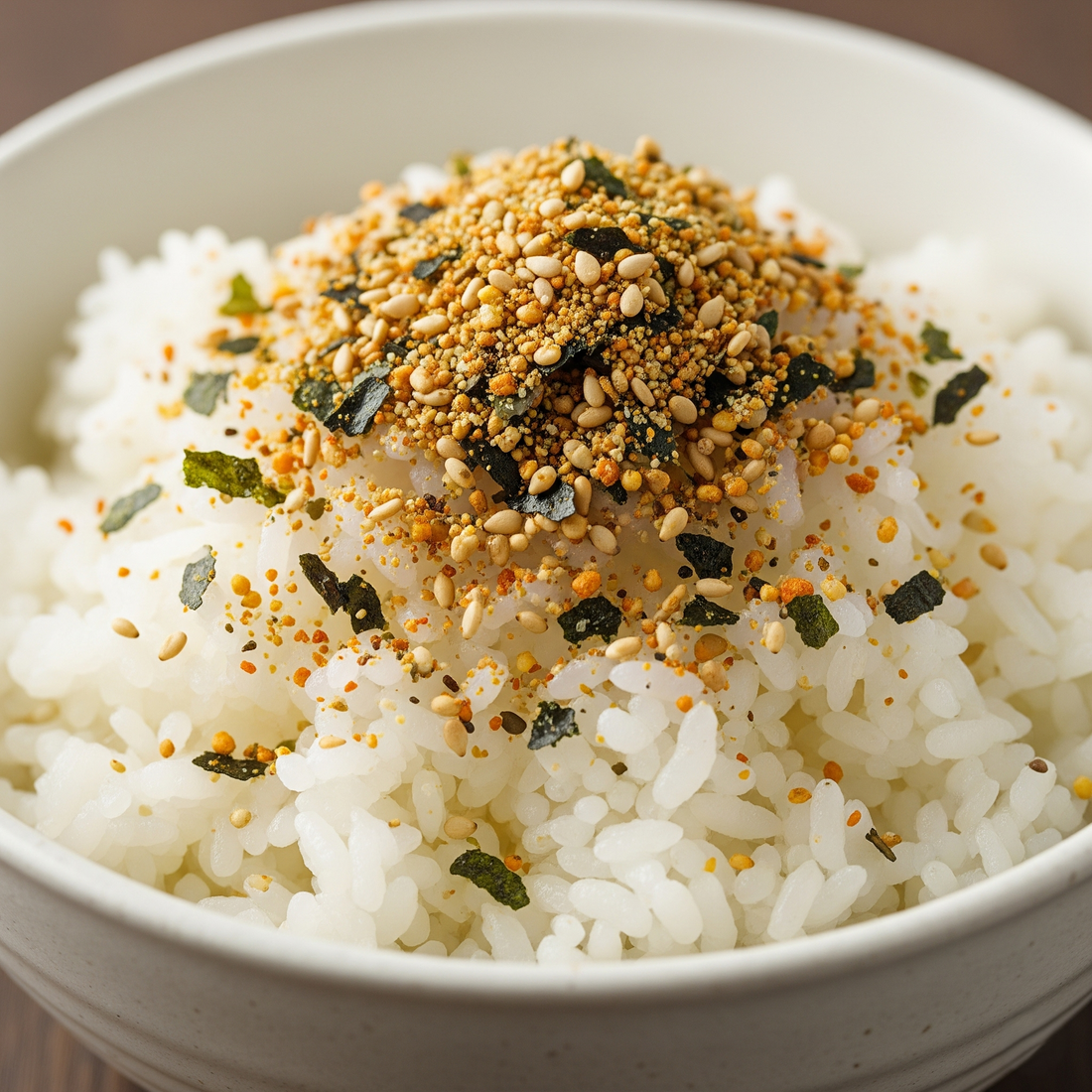Most people assume Furikake rice seasoning is just a fun sprinkle—harmless, flavorful, and nothing to think twice about.
It’s seaweed and sesame seeds, right? How bad could it be? That’s the simplified view.
But like many pantry staples, the reality lies in the label—and it’s not always as clean as the packaging suggests. Some blends pack in MSG, high sodium, artificial colors, or even allergens that can sneak past an untrained eye.
Something that seems healthy at first can hurt your clean eating goals—or even cause unexpected dietary problems.
The smarter approach? Know exactly what goes into your Furikake.
Choose blends that align with your health goals, special diets, and daily use, without compromising flavor. This blog breaks down the real ingredients, the hidden pros and cons, and how to enjoy Furikake in a way that’s good for your body, not just your taste buds.
What is Furikake seasoning made of?
At first glance, Furikake seems simple. But a closer look at the label reveals that not all blends are created equal. Traditionally, Furikake seasoning is made from a base of roasted seaweed (nori), toasted sesame seeds, salt, and sugar.
These core ingredients deliver the classic umami crunch that you love. But modern store-bought versions often add more than just flavor—they include dried fish flakes (like bonito or salmon), powdered soy sauce, miso, dehydrated egg, MSG, and even artificial colors or preservatives.
The variety is wide—some blends are minimalist and clean, while others read more like a chemistry set. That’s why scanning the ingredient list matters, especially if you’re avoiding gluten, animal products, or excess sodium.
For example, bonito-based Furikake isn’t vegan, and soy sauce powder may contain wheat, making it unsuitable for gluten-free diets. If you're reaching for Furikake thinking it’s just a healthy seasoning, think again. The ingredients can shift it from a smart choice to a sneaky source of additives.
Is Furikake seasoning healthy?
Furikake often shows up on grocery shelves looking innocent, colorful flakes promising instant flavor.
But is it healthy?
That depends on what’s hiding in those tiny granules. At first glance, Furikake seems like a smart choice: it’s built around seaweed and sesame seeds, both known for their nutritional perks. Seaweed offers iodine and antioxidants; sesame brings healthy fats and fiber.
Sounds great so far.
But dig a little deeper, and you’ll notice not all blends are created equal. Some furikake blends keep it simple, but others add things like extra salt, sugar, MSG, or artificial colors, turning a healthy choice into something less clean.
The truth is, Furikake can sit somewhere between a wholesome topping and a processed snack, depending on what you buy and how you use it. It’s not about labeling it “good” or “bad,” but about knowing what you’re sprinkling on your food.
Health benefits of Furikake
What makes Furikake more than just a flavorful topping?
The answer lies in its ingredients and how they work together to add both taste and nutrition to your meals.
Seaweed, one of the main components of Furikake, is a natural source of iodine, which is essential for thyroid function. It also contains minerals like calcium and iron, along with antioxidants that help fight oxidative stress. These nutrients are often missing from typical Western diets, making seaweed a small but mighty addition.
Then there are sesame seeds, rich in healthy fats and dietary fiber. These seeds provide plant-based omega-6 fatty acids and lignans, which support heart health and digestion. Together, seaweed and sesame create a nutrient-dense blend that can upgrade even the simplest bowl of rice.
Another underrated benefit of Nori Komi Furikake is its strong umami flavor. This savory punch allows you to cut back on heavy sauces or excessive oil and salt.
That brings you to a common question: Is furikake good for weight loss?
Yes, it can be—when used mindfully. Its flavor helps enhance healthy, low-calorie meals, making it easier to stick to clean eating without feeling deprived.
But—is Furikake high in sodium?
Some blends can be. While seaweed itself contains natural sodium, added salt, soy sauce powder, or MSG in commercial versions can raise sodium levels. That’s why it’s important to check the label and use Furikake as a light sprinkle, not a heavy pour.
Is Furikake healthy for everyday use?
Furikake can be healthy for everyday use—if you choose the right kind and use it in small amounts. It’s made with ingredients like seaweed and sesame seeds, which offer important nutrients such as iodine, healthy fats, and fiber. These can support your thyroid, digestion, and overall health.
The real benefit of Furikake is its strong umami flavor. Just a little can add a big taste boost to plain rice, eggs, or veggies. This helps you enjoy simple meals without adding heavy sauces or extra oil. However, some store-bought Furikake blends may contain added salt, sugar, MSG, or preservatives.
If eaten in large amounts daily, these extras could affect your health, especially if you're watching your sodium intake. But as long as you choose clean, low-sodium versions and use it as a seasoning rather than a main ingredient, a small sprinkle each day can be a tasty, health-friendly choice.
Is Furikake safe for special diets?
Furikake can fit into many special diets, but it’s important to read the label carefully.
If you're following a vegan or vegetarian diet, avoid blends that contain bonito flakes (dried fish) or dried egg. These are common in traditional Furikake, so look for plant-based versions made only with seaweed, sesame seeds, and spices.
For those who need to eat gluten-free, Furikake can be tricky. Some blends include soy sauce powder or wheat starch, which contain gluten. Always check for a gluten-free label or choose a brand that lists safe, gluten-free ingredients.
Wondering if kids can eat Furikake?
Yes—but choose wisely. Go for low-sodium, additive-free versions without MSG, artificial colors, or preservatives. A simple mix of seaweed and sesame seeds can be a fun, flavorful way to add nutrients to a child’s meal. With its slightly sweet, salty, and umami flavor, Nori Komi Furikake rice seasoning made with textured nori seaweed and sesame seeds shows exactly why it’s been an island favorite for so long.
Tips for choosing a healthier Furikake
- Check the ingredient list: Look for short, simple ingredients like seaweed, sesame seeds, and spices.
- Avoid artificial additives: Opt for blends without MSG, artificial colors, or preservatives.
- Watch the sodium: Choose low-sodium versions, especially if you’re using it daily.
- Skip added sugars: Some blends include sugar or glucose—unnecessary for a savory topping.
- Look for gluten-free labeling: If you’re gluten-sensitive, check for wheat starch or soy sauce powder.
- Go plant-based if needed: Vegans and vegetarians should avoid bonito flakes and egg powder.
- Buy from trusted brands: Select brands that list their ingredients and cater to specific dietary needs.
- Use it sparingly: Even the healthiest Furikake should be used as a seasoning, not a main ingredient.
Final words
Furikake rice seasoning may look like a simple topping, but what’s inside can make a big difference to your health. While seaweed and sesame seeds offer real nutritional value, not all blends are created equal. Some include added sugars, artificial flavors, or high sodium that can quietly work against your wellness goals. The key is choosing cleaner options with short ingredient lists and no unnecessary fillers.
That’s where brands like Pono Hawaiian Foods stand out, offering Furikake blends made with gluten-free, plant-based ingredients and zero artificial junk. It's a flavor you can feel good about. So, if you’re looking to enjoy Furikake every day without the guesswork, go for mindful blends and sprinkle smart.

